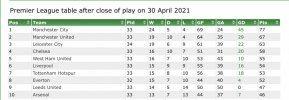drippin
Obsessed with "Mature Trusted Members"
Country: Finland
The moment he signed the contract at Arsenal, his value jumped up a lot.What has Jesus done this season to increase his value by 30m? The list of players’ value is wrong which was the original point.
You can look at the Richarlison price, which was 15 million pounds more than Jesus. He had 2 years left while Jesus had 1 year left.
How much do you think Jesus is worth after his performances this season, with 4 years in contract?
Besides, the difference isn't 30 million like you say, because he cost 45 million pounds and that number is 75 million euros, not pounds.

 whereby we were sitting in mid table mediocrity below scrubs like Leeds, Everton etc.
whereby we were sitting in mid table mediocrity below scrubs like Leeds, Everton etc.
